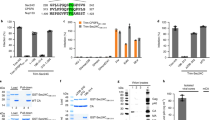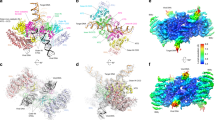Abstract
The limited coding capacity of retroviral genomes forces these viruses to rely heavily on the host-cell machinery for their replication. This phenomenon is particularly well illustrated by the interaction between retroviruses and components of the endosomal budding machinery that occurs during virus release. Here, we focus on the use of host-cell factors during HIV-1 budding and highlight recent progress in our understanding of the role of one such factor, Alix, in both viral and cellular membrane budding and fission events.
This is a preview of subscription content, access via your institution
Access options
Subscribe to this journal
Receive 12 print issues and online access
$209.00 per year
only $17.42 per issue
Buy this article
- Purchase on Springer Link
- Instant access to full article PDF
Prices may be subject to local taxes which are calculated during checkout



Similar content being viewed by others
References
Swanstrom, R. & Wills, J. W. in Synthesis, Assembly, and Processing of Viral Proteins 263–334 (Cold Spring Harbor Laboratory Press, New York, 1997).
Freed, E. O. HIV-1 gag proteins: diverse functions in the virus life cycle. Virology 251, 1–15 (1998).
Gottlinger, H. G., Dorfman, T., Sodroski, J. G. & Haseltine, W. A. Effect of mutations affecting the p6 gag protein on human immunodeficiency virus particle release. Proc. Natl Acad. Sci. USA 88, 3195–3199 (1991).
Huang, M., Orenstein, J. M., Martin, M. A. & Freed, E. O. p6Gag is required for particle production from full-length human immunodeficiency virus type 1 molecular clones expressing protease. J. Virol. 69, 6810–6818 (1995).
Puffer, B. A., Parent, L. J., Wills, J. W. & Montelaro, R. C. Equine infectious anemia virus utilizes a YXXL motif within the late assembly domain of the Gag p9 protein. J. Virol. 71, 6541–6546 (1997).
Wills, J. W. et al. An assembly domain of the Rous sarcoma virus Gag protein required late in budding. J. Virol. 68, 6605–6618 (1994).
Bieniasz, P. D. Late budding domains and host proteins in enveloped virus release. Virology 344, 55–63 (2006).
Demirov, D. G. & Freed, E. O. Retrovirus budding. Virus Res. 106, 87–102 (2004).
Morita, E. & Sundquist, W. I. Retrovirus budding. Annu. Rev. Cell Dev. Biol. 20, 395–425 (2004).
Katzmann, D. J., Odorizzi, G. & Emr, S. D. Receptor downregulation and multivesicular-body sorting. Nature Rev. Mol. Cell Biol. 3, 893–905 (2002).
Garrus, J. E. et al. Tsg101 and the vacuolar protein sorting pathway are essential for HIV-1 budding. Cell 107, 55–65 (2001).
VerPlank, L. et al. Tsg101, a homologue of ubiquitin-conjugating (E2) enzymes, binds the L domain in HIV type 1 Pr55Gag. Proc. Natl Acad. Sci. USA 98, 7724–7729 (2001).
Demirov, D. G., Ono, A., Orenstein, J. M. & Freed, E. O. Overexpression of the N-terminal domain of TSG101 inhibits HIV-1 budding by blocking late domain function. Proc. Natl Acad. Sci. USA 99, 955–960 (2002).
Martin-Serrano, J., Zang, T. & Bieniasz, P. D. HIV-1 and Ebola virus encode small peptide motifs that recruit Tsg101 to sites of particle assembly to facilitate egress. Nature Med. 7, 1313–1319 (2001).
Odorizzi, G. The multiple personalities of Alix. J. Cell Sci. 119, 3025–3032 (2006).
Fisher, R. D. et al. Structural and biochemical studies of ALIX/AIP1 and its role in retrovirus budding. Cell 128, 841–852 (2007).
Hurley, J. H. & Emr, S. D. The ESCRT complexes: structure and mechanism of a membrane-trafficking network. Annu. Rev. Biophys. Biomol. Struct. 35, 277–298 (2006).
Kim, J. et al. Structural basis for endosomal targeting by the Bro1 domain. Dev. Cell 8, 937–947 (2005).
Schmidt, M. H., Dikic, I. & Bogler, O. Src phosphorylation of Alix/AIP1 modulates its interaction with binding partners and antagonizes its activities. J. Biol. Chem. 280, 3414–3425 (2005).
Lee, S., Joshi, A., Nagashima, K., Freed, E. O. & Hurley, J. H. Structural basis for viral late-domain binding to Alix. Nature Struct. Mol. Biol. 14, 194–199 (2007).
Missotten, M., Nichols, A., Rieger, K. & Sadoul, R. Alix, a novel mouse protein undergoing calcium-dependent interaction with the apoptosis-linked-gene 2 (ALG-2) protein. Cell Death Differ. 6, 124–129 (1999).
Vito, P., Pellegrini, L., Guiet, C. & D'Adamio, L. Cloning of AIP1, a novel protein that associates with the apoptosis-linked gene ALG-2 in a Ca2+-dependent reaction. J. Biol. Chem. 274, 1533–1540 (1999).
Trioulier, Y. et al. Alix, a protein regulating endosomal trafficking, is involved in neuronal death. J. Biol. Chem. 279, 2046–2052 (2004).
Martin-Serrano, J., Yarovoy, A., Perez-Caballero, D. & Bieniasz, P. D. Divergent retroviral late-budding domains recruit vacuolar protein sorting factors by using alternative adaptor proteins. Proc. Natl Acad. Sci. USA 100, 12414–12419 (2003).
Strack, B., Calistri, A., Craig, S., Popova, E. & Gottlinger, H. G. AIP1/ALIX is a binding partner for HIV-1 p6 and EIAV p9 functioning in virus budding. Cell 114, 689–699 (2003).
von Schwedler, U. K. et al. The protein network of HIV budding. Cell 114, 701–713 (2003).
Chen, C., Vincent, O., Jin, J., Weisz, O. A. & Montelaro, R. C. Functions of early (AP-2) and late (AIP1/ALIX) endocytic proteins in equine infectious anemia virus budding. J. Biol. Chem. 280, 40474–40480 (2005).
Demirov, D. G., Orenstein, J. M. & Freed, E. O. The late domain of human immunodeficiency virus type 1 p6 promotes virus release in a cell type-dependent manner. J. Virol. 76, 105–117 (2002).
Munshi, U. M., Kim, J., Nagashima, K., Hurley, J. H. & Freed, E. O. An Alix fragment potently inhibits HIV-1 budding: characterization of binding to retroviral YPXL late domains. J. Biol. Chem. 282, 3847–3855 (2007).
Usami, Y., Popov, S. & Gottlinger, H. G. Potent rescue of human immunodeficiency virus type 1 late domain mutants by ALIX/AIP1 depends on its CHMP4 binding site. J. Virol. 81, 6614–6622 (2007).
Carlton, J. G. & Martin-Serrano, J. Parallels between cytokinesis and retroviral budding: a role for the ESCRT machinery. Science 316, 1908–1912 (2007).
Fabbro, M. et al. Cdk1/Erk2- and Plk1-dependent phosphorylation of a centrosome protein, Cep55, is required for its recruitment to midbody and cytokinesis. Dev. Cell 9, 477–488 (2005).
Ichioka, F. et al. HD-PTP and Alix share some membrane-traffic related proteins that interact with their Bro1 domains or proline-rich regions. Arch. Biochem. Biophys. 457, 142–149 (2007).
Morita, E. et al. Identification of human MVB12 proteins as ESCRT-I subunits that functions in HIV budding. Cell Host Microbe 2, 41–53 (2007).
Horii, M. et al. CHMP7, a novel ESCRT-III-related protein, associates with CHMP4b and functions in the endosomal sorting pathway. Biochem. J. 400, 23–32 (2006).
Jouvenet, N. et al. Plasma membrane is the site of productive HIV-1 particle assembly. PLoS Biol. 4, e435 (2006).
Booth, A. M. et al. Exosomes and HIV Gag bud from endosome-like domains of the T cell plasma membrane. J. Cell Biol. 172, 923–935 (2006).
Deneka, M., Pelchen-Matthews, A., Byland, R., Ruiz-Mateos, E. & Marsh, M. In macrophages, HIV-1 assembles into an intracellular plasma membrane domain containing the tetraspanins CD81, CD9, and CD53. J. Cell Biol. 177, 329–341 (2007).
Welsch, S. et al. HIV-1 buds predominantly at the plasma membrane of primary human macrophages. PLoS Pathog. 3, e36 (2007).
Nydegger, S., Foti, M., Derdowski, A., Spearman, P. & Thali, M. HIV-1 egress is gated through late endosomal membranes. Traffic 4, 902–910 (2003).
Perlman, M. & Resh, M. D. Identification of an intracellular trafficking and assembly pathway for HIV-1 gag. Traffic 7, 731–745 (2006).
Acknowledgements
The authors thank W. S. Hu, V. Pathak and members of the Freed laboratory for the critical review of the manuscript. Work in the authors' laboratories is supported by intramural grant support from the Center for Cancer Research, the National Cancer Institute, the National Institute of Diabetes and Digestive and Kidney Diseases and the Intramural AIDS Targeted Antiviral Program.
Author information
Authors and Affiliations
Corresponding author
Rights and permissions
About this article
Cite this article
Fujii, K., Hurley, J. & Freed, E. Beyond Tsg101: the role of Alix in 'ESCRTing' HIV-1. Nat Rev Microbiol 5, 912–916 (2007). https://doi.org/10.1038/nrmicro1790
Issue Date:
DOI: https://doi.org/10.1038/nrmicro1790
This article is cited by
-
The roles of small extracellular vesicles in cancer and immune regulation and translational potential in cancer therapy
Journal of Experimental & Clinical Cancer Research (2022)
-
Recombinant extracellular vesicles as biological reference material for method development, data normalization and assessment of (pre-)analytical variables
Nature Protocols (2021)
-
The generation and use of recombinant extracellular vesicles as biological reference material
Nature Communications (2019)
-
The KT Jeang Retrovirology prize 2018: Eric Freed
Retrovirology (2018)
-
PYRE insertion within HIV-1 subtype C p6-Gag functions as an ALIX-dependent late domain
Scientific Reports (2018)



